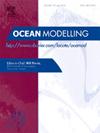Impact of sea ice friction on ocean tides in the Arctic Ocean, modelling insights at various time and space scales
IF 2.9
3区 地球科学
Q2 METEOROLOGY & ATMOSPHERIC SCIENCES
引用次数: 0
Abstract
Although ocean tides are one of the major contributors to the energy dissipation in the Arctic Ocean, they remain relatively poorly known, particularly their interactions with the ice cover (sea ice and grounded ice). These interactions are often simply ignored in tidal models, or considered through relatively simple combinations with the bottom friction. In this paper, we investigate the response of a regional pan-Arctic ocean tidal model to the friction under the sea ice cover, in order to better understand the influence of this parameter on tidal estimates. Different periods of time, from seasonal to decadal scales, were considered to analyze the impact of the variations in the sea ice cover on the ocean tides, in the region as well as at global scale. Long-distance effects of Arctic sea ice friction are revealed in the global tidal simulations, resulting in variations of several centimeters in the seasonal tidal amplitudes. Tide gauge and satellite altimetry observations were specifically processed to retrieve the tidal harmonic constituents over different periods and different sea ice conditions, to compare with the model simulations. Improving the knowledge on the interaction between the tides and the sea ice cover, and thus the performance of the tidal models in the polar regions, is of particular interest to generate more realistic simulations with ocean circulation models, to contribute to scientific investigations on the changes in the Arctic Ocean, and also to improve the satellite altimetry observation retrievals at high latitudes, as the tidal signals remain a major contributor to the error budget of the satellite altimetry observations in the Arctic Ocean. This work also highlights the difficulty to assess the temporal evolution of tides in model simulations in the Arctic because of the lack of long (i.e. several decades) hourly tide gauge observation records in the area.
海冰摩擦对北冰洋海潮的影响,在不同时间和空间尺度上的模拟见解
虽然海潮是北冰洋能量耗散的主要贡献者之一,但对它们的了解相对较少,特别是它们与冰盖(海冰和接地冰)的相互作用。这些相互作用通常在潮汐模型中被简单地忽略,或者通过与底部摩擦的相对简单的组合来考虑。本文研究了区域泛北冰洋潮汐模式对海冰下摩擦力的响应,以便更好地了解该参数对潮汐估计的影响。考虑了从季节尺度到年代际尺度的不同时期,以分析该区域以及全球尺度上海冰覆盖变化对海洋潮汐的影响。在全球潮汐模拟中揭示了北极海冰摩擦的远距离影响,导致季节潮汐振幅变化数厘米。对不同时期和不同海冰条件下的潮汐谐波成分进行了处理,并与模式模拟结果进行了比较。提高对潮汐和海冰之间相互作用的认识,从而提高极地潮汐模式的性能,对于用海洋环流模式产生更真实的模拟,有助于对北冰洋变化的科学研究,也有助于改进高纬度地区卫星测高观测的反演,具有特别重要的意义。因为潮汐信号仍然是造成北冰洋卫星测高观测误差预算的主要因素。这项工作还强调了在北极模式模拟中评估潮汐时间演变的困难,因为该地区缺乏长时间(即几十年)的每小时潮汐计观测记录。
本文章由计算机程序翻译,如有差异,请以英文原文为准。
求助全文
约1分钟内获得全文
求助全文
来源期刊

Ocean Modelling
地学-海洋学
CiteScore
5.50
自引率
9.40%
发文量
86
审稿时长
19.6 weeks
期刊介绍:
The main objective of Ocean Modelling is to provide rapid communication between those interested in ocean modelling, whether through direct observation, or through analytical, numerical or laboratory models, and including interactions between physical and biogeochemical or biological phenomena. Because of the intimate links between ocean and atmosphere, involvement of scientists interested in influences of either medium on the other is welcome. The journal has a wide scope and includes ocean-atmosphere interaction in various forms as well as pure ocean results. In addition to primary peer-reviewed papers, the journal provides review papers, preliminary communications, and discussions.
 求助内容:
求助内容: 应助结果提醒方式:
应助结果提醒方式:


